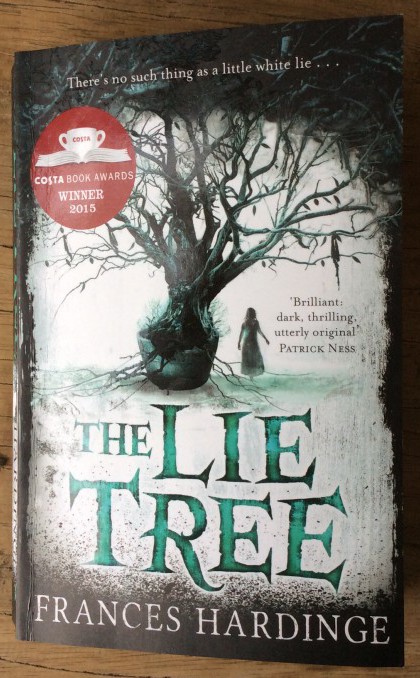Inspiring Young Readers
 posted on 15 Mar 2016
posted on 15 Mar 2016
The Lie Tree by Frances Hardinge
I usually try to avoid looking at reviews before writing my own but must confess that I had absorbed plenty of very positive accolades before even starting to read this 2015 Costa prize winning book. So I was expecting it to be ground breaking, magical and packed with vividly crafted beautiful prose. And somewhat to my surprise - it was.
This is Frances Hardinge's seventh novel and is a clever mix of fairy tale, fantasy, thriller, detective and historical genres. At its heart is the very real conflict between science and religion that defined the Victorian age after the publication of Darwin’s The Origin of Species. Strongly influenced by the theory of evolution, Reverend Erasmus Sunderly has always been highly respected naturalist but the novel begins with him fleeing to a remote island with his wife, brother in law and two children because of a scandal. He is soon found dead under unexplained circumstances that threaten to destroy the reputation of his surviving family. It becomes clear that he has been forced to flee from the mainland due to many dark secrets including his discovery of a sinister plant known as The Tree of Lies. He has hidden it away on the island as it apparently feeds off whispered lies and bears fruits that reveal secrets.
His teenage daughter Faith is determined to untangle the various mysteries and to find The Tree of Lies. She is a strong and likeable female protagonist who is raging against the constraints of her conventional, stuffy upbringing. Before everything goes badly wrong she had always been an enthusiastic and curious child, helping her father with his fossil collection. She is angry and bitter that as she grows older, he begins to exclude her and she is keenly aware that she doesn't fit the social expectations of being a quiet, compliant female.
This is also a coming of age novel as Faith articulates her general dissatisfaction with her parents and her dreams for the future. She is frustrated that it feels as if her brain is too tightly packed with scientific knowledge that makes men (including her own father) very uncomfortable. She is aware that she doesn’t ‘fit’ and part of this is expressed by describing her physical discomfort when she is expected to wear a training bodice. She certainly does not want to emulate her embarrassing mother, Myrtle, who uses her femininity to charm men, particularly when events mean that she needs protection.
Despite her many frustrations, I like the way that Faith uses her perceived weakness to her advantage by being relatively invisible and unimportant – this makes her able to explain her necessarily frequent absences to solve the mystery of her father’s death by retiring to her room feeling delicate or generally unwell. As the plot develops we see her grow in confidence, be able to challenge authority and make brave and often dangerous decisions.
As we know, infant mortality was still very high in the nineteenth century and Faith has already experienced the deaths of five younger male siblings over the years. Her surviving six year old brother Howard is understandably precious and she is expected to help protect him. One of her responsibilities is to make sure that he wears a specially designed tunic that prevents him from using his left hand when writing. This is an example of how Hardinge weaves in lots of interesting information about uncontested views of the time. Similarly, the Victorian fashion for measuring people skulls acts a way of predicting intelligence and explaining abhorrent behaviour is a strong theme.
As indicated in many reviews, the language is often extraordinary ‘thoughts squirming behind his placid face like worms in a bun’ is one of my favourites. The description of pruning the leaves of the burgeoning tree as ‘trimming the toenails of a dragon’ is fabulous.
I really enjoyed this unusual book with its many layers and themes that kept me engaged from the opening scene right through various melodramatic and sometimes frightening events. I have deliberately avoided giving much of the plot away because the conundrum of The Lie Tree at its centre is designed to keep the reader turning the pages. I wasn't convinced who the baddies were until right towards the end which is reason enough to recommend it.
Karen Argent
12th March 2016